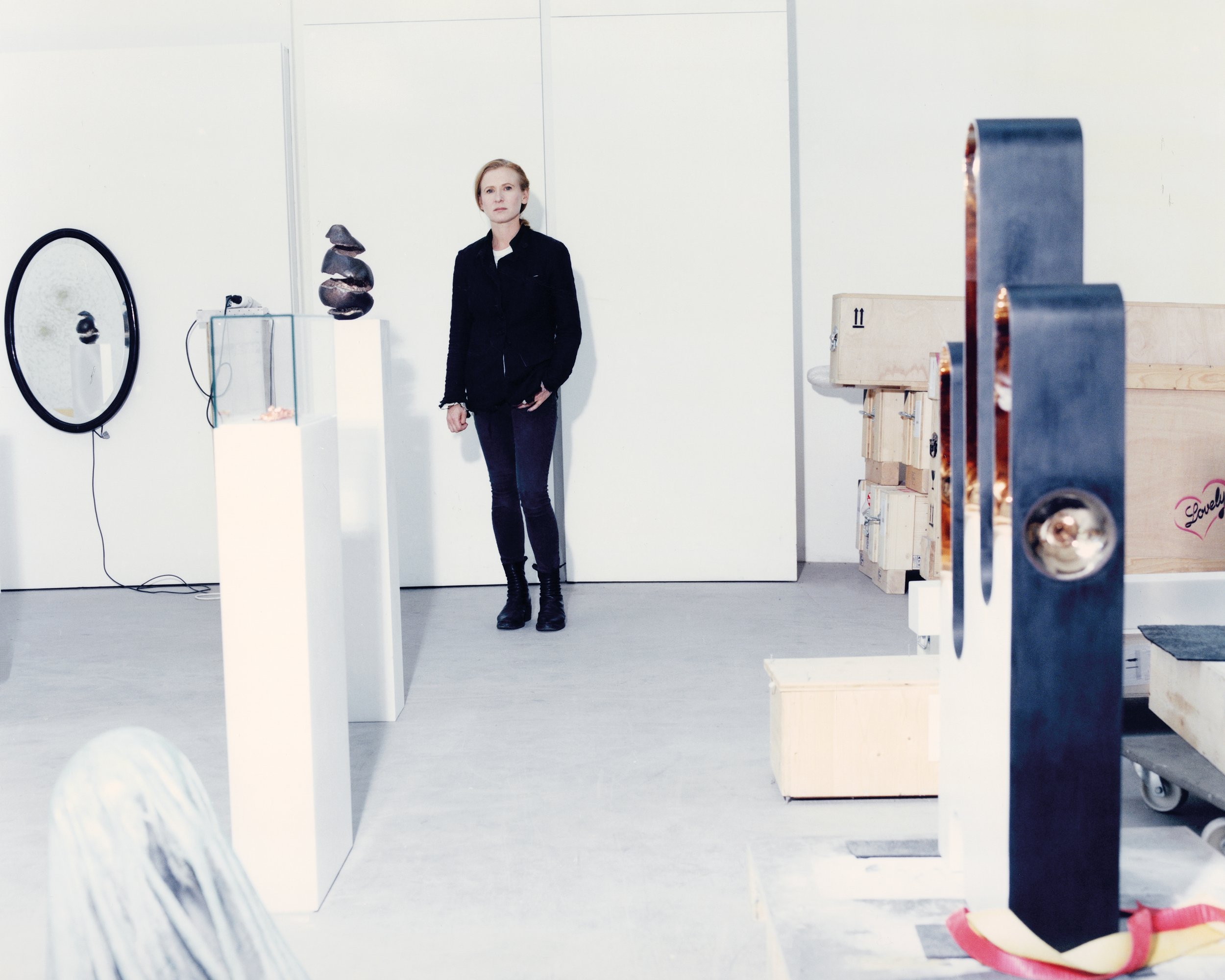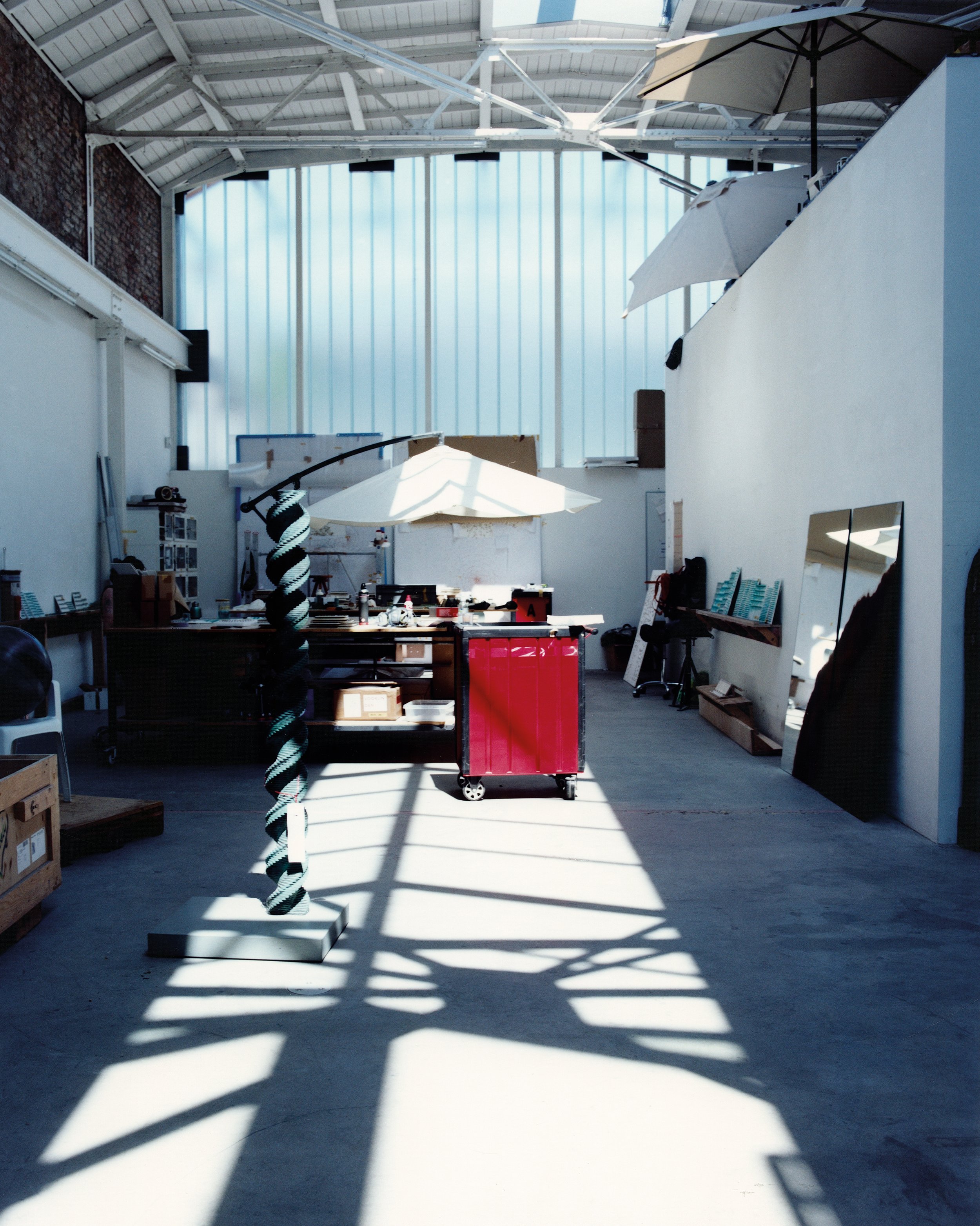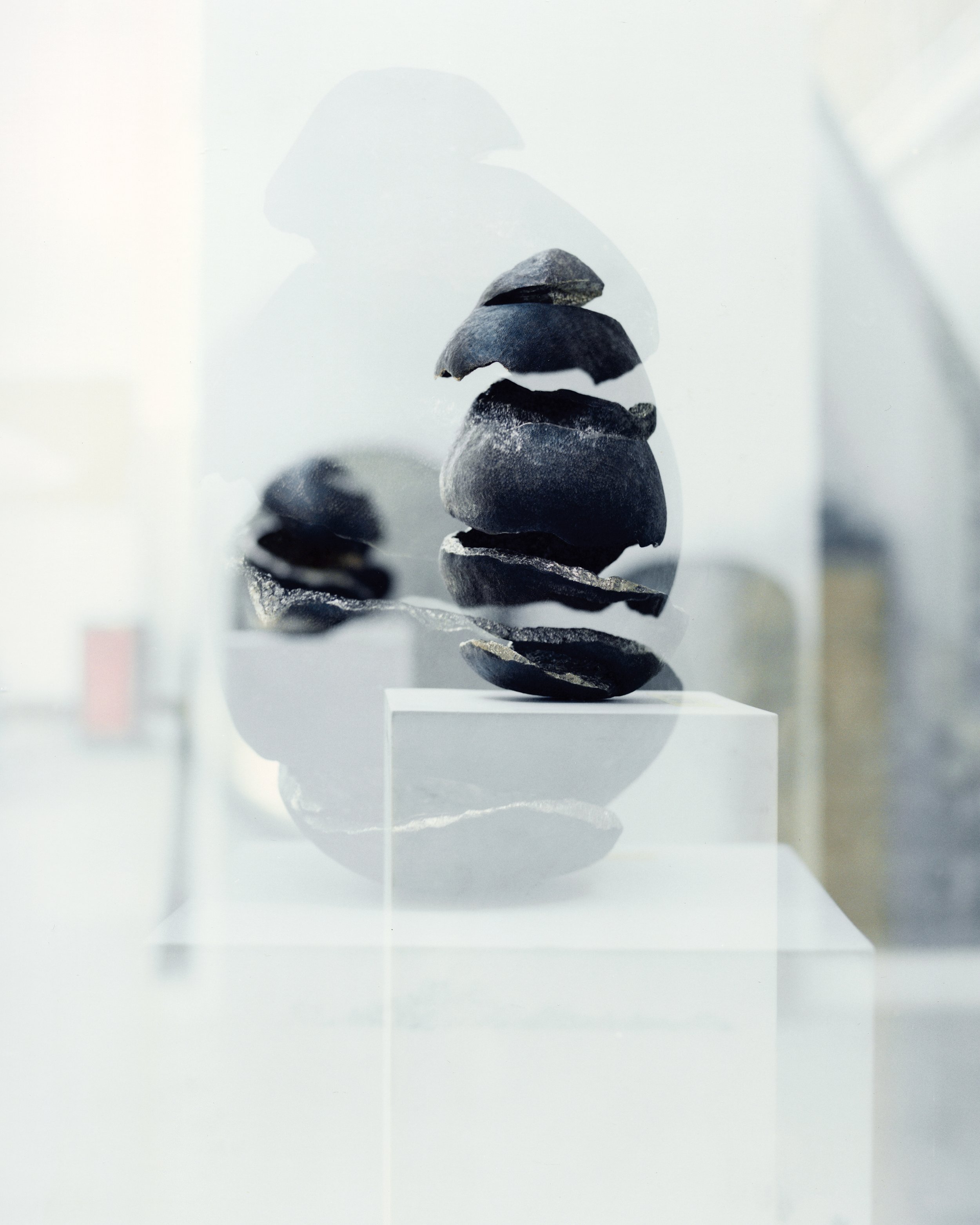Alicja Kwade | Philosopher’s Stone
One is immediately captivated by Alicja Kwade’s work upon first encounter. Not necessarily due to its physical dominance in a crowded plaza in Paris or the snowy landscape of Gstaad, but because it compels the observer to question what they are seeing, thereby inviting closer inspection. If you find yourself asking, “What am I looking at?,” you are engaging with her work in the intended manner.
Kwade’s formative years in Poland and Germany have profoundly influenced her artistic vision. She describes her upbringing in two contrasting systems—socialist and extremely Catholic Poland, followed by a sudden shift to capitalist West Germany. This dual experience, she believes, has rendered her immune to many prejudices and provided a unique perspective that inevitably permeates her work.
Central to Kwade’s work is the exploration of “not-knowing” and “nothingness.” She views these concepts as fundamental to the human condition, reflecting humanity’s perpetual struggle to comprehend existence and the universe. Much like the legendary Philosopher’s Stone, which alchemists believed could transform base metals into gold and grant eternal life, Kwade’s art transforms everyday perceptions and invites viewers to engage in a deeper philosophical quest. Embracing this void allows her to create with a freedom that defies the need for external validation. Her interdisciplinary approach encompasses sculpture and installations, incorporating elements of language, philosophy, and science to encourage viewers to embrace uncertainty, question the familiar, and find humor in the absurdities of existence. Kwade acknowledges, “As a human being, I can’t help but view everything from this central position, even though I would prefer to do it differently,” and her work offers an alternative way of perceiving the world.
Through her unconventional use of mirrors to subvert their traditional function in art, her displacement of everyday objects, and her nontraditional sharing of genetic information with exhibition visitors, she aggressively challenges herself to understand the limits of human perception and the implications of these boundaries.
During a recent studio visit to her Berlin space, we gained insight into her working environment, where she continually questions the nature of reality: “I question the reality of the ground beneath me and the blue of the sky above. Are they truly real, or are they perceptions?”
Q: Growing up in Poland and Germany, how have your cultural influences shaped your artistic vision and the themes of humanity in your work?
A: I find it difficult to judge how these influences have shaped my artistic vision and the human themes in my work, as I have never looked for influences or an imprint that has to do with my biography.
I grew up in two completely different systems: socialist and extremely catholic Poland, and then, from one day to the next, capitalist West Germany. These were two parallel worlds that existed side by side. I think this dual experience profoundly affected me and made me immune to many prejudices. Even though I was still a child when my family left Poland, I had the opportunity to understand two perspectives. The experiences of being in a foreign world as a Polish emigrant, living in refugee homes, and lacking language skills certainly impacted me, and these influences inevitably flow into my work.
Q: You often explore “not-knowing” and “nothingness.” How do these concepts influence your creative process?
A: I believe this is the most significant and oldest issue faced by humanity. It is an inherent part of the human experience. We have no understanding of our purpose, are not able to grasp the complexity of existence and the universe, and yet we are continually confronted by it, always striving to make sense of it. We are all random events in time and space trying to understand something that is much bigger than ourselves, so we invent all kinds of absurd things that will allow us to somehow live together on a rotating blue ball in the void.
This absurd situation actually makes me laugh a little. You can only view it with irony or even sarcasm as we invent all these fictitious mechanisms of oppression to somehow improve our position, find support, and justify our existence. This pattern repeats itself across all cultures and generations.
We all know the quote from Socrates, “I know that I know nothing,” or I think Arthur Schopenhauer sums it up with, “Everyone wants to live, but no one knows why.”
And even if you look at it objectively, the more closely you deal with an object or issue, the more inevitably you end up in nothingness. No matter the topic, eventually you confront the void of the universe and the limits of human imagination. I treat nothingness as my greatest ally because it frees me from the need to prove anything or adhere to anything. That is the essence of being an artist; you create your own imagination and your own laws from nothingness, from within yourself – and that is what you must face.
Alicja Kwade, Die beweegte Leere des Moments, 2015. Installation View, Schirn Kunsthalle, Frankfurt, 2015. Photo: Norbert Miguletz. © Schirn Kunsthalle Frankfurt
Q: Your installations, like The Void of the Moment in Motion, often reference scientific concepts. How do you balance the cold precision of science with the warmth of human experience in your work?
A: I don’t believe in the dichotomy of scientific coldness and human warmth. There are poetic approaches to science and also cold, harsh approaches to humanity. Moreover, I don’t engage with science as a scientist would. I am not trying to prove anything or maintain precision. Science, as well as philosophy, sociology and other disciplines are sources of inspiration.
Q: Many of your works involve philosophical inquiries into identity and existence. How do these explorations manifest humanistic themes in your art?
A: For me, it’s all about the existence of humanity and everything we perceive or describe as real with our limited senses. I am deeply fascinated by this persistent illusion and the evolution of free will. I’m intrigued by the helplessness, the defenses, and the absurdity of human beings, but most importantly, by what lies beyond our understanding. This is the starting point of my work.
Q: Your frequent travels and projects across various countries have fueled your work. How does this sense of dislocation influence your exploration of themes?
A: I reject the concept of home. The notion of home can be dangerous, as it often serves as the starting point for numerous conflicts. I am fundamentally opposed to individualism and believe we should emphasize our similarities more than our differences. It doesn’t matter to me where someone comes from, what country they belong to, what passport they hold, or where they grew up, their gender, or their skin color. These factors don’t interest me. We are all very similar, with the same needs and sense of pain; our differences are insignificant.
In 2020, I created a piece where I had my entire DNA mapped. Through this, I learned especially about how alike we all are. This sense of dislocation has driven me to want to sever any roots I see as hindrances to freely navigating the world. This work, where I had my DNA read, along with research on statistics, human fear and its origins, asteroids passing by Earth, the pursuit of the smallest particles through string theory, and attempts to comprehend time—all of these have profoundly influenced my work.
Alicja Kwade, details of Gegebenenfalls die Wirklichkeit (Alicja), 2019. Installation View, Museum Voorlinden, 2024. Courtesy the artist and Pace Gallery. Photo: Antoine van Kaam. © Alicja Kwade
Q: You’ve expressed interest in how language shapes thought. Can you share more about how this idea manifests in your work and any personal experiences that have influenced this exploration?
A: We are the ones who must communicate and name everything, finding words to express our reality. If there is no word for a feeling or an object, it essentially does not exist. We bring the world into being through our actions and the development of language, which are necessary for our survival. We must name these objects, feelings, or facts; without communication, they do not exist.
When I came to Germany, my brother and I contracted tuberculosis in a refugee center, and we had to go to a health resort. There were many other children there, and we slept in large shared dormitories. Before going to sleep, everyone cried and screamed terribly that they were homesick, or “krank vor Heimweh.” At that time, I understood very little German, and I thought they all had “Beinweh,” which sounds similar but means “leg pain.” I told my mother about it, and we puzzled over what could be wrong with the children’s legs. Of course, I missed my family and my home, but I couldn’t share this collective feeling of “homesickness” because this word doesn’t exist in Polish. It was both funny and sad at the same time.
Alicja Kwade, ParaPivot (sempiternal clouds), 2020. Installation View, Desert X, Coachella Valley, 2021. Photo: Lance Gerber. © Alicja Kwade
Q: Your work, such as ParaPivot, blends art, science, and philosophy. How do you ensure that the human element remains central in this interdisciplinary approach?
A: Everything always revolves around people. We are not able to leave this circle, akin to a dog constantly trying to bite its own tail. We cannot escape because we cannot perceive ourselves from the outside, and thus, we humans always remain at the center. As a human being, I can’t help but view everything from this central position, even though I would prefer to do it differently.
Q: In pieces like WeltenLinie, you create illusions that shift with perspective. How do you hope to change viewers’ perceptions of their own reality and humanity through your art?
A: My aim is for people to feel uncertain about their own perspective on the world, to lose their orientation a little, and to reconsider their own point of view and their perception of the world. I aim to provoke questions, to raise awareness about how easily we can be deceived and how readily we believe things. Through this, I hope people will cultivate doubt and not take everything at face value. At the same time, I also want people to have fun, to laugh, to be enchanted.
Q: You often transform everyday objects to challenge their conventional meanings. Can you discuss the significance of this transformation in your work and how it reflects your views on object identity?
A: I don’t believe in objects. To me, all objects, including myself, are chance occurrences in space and time that we utilize, name, and define. When you delve deeply into this concept, you inevitably ask: where does one object truly end and the next begin?
What defines an object? On a microscopic scale, molecules seamlessly blend together, erasing boundaries such as where stones end and sky begins. And if an object is defined by our social actions and necessities—like sitting together, eating, or discussing—does a chair remain a chair, or is it still fundamentally a tree? What does that distinction really imply?
These are questions that constantly occupy my thoughts. I question the reality of the ground beneath me and the blue of the sky above. Are they truly real, or are they perceptions? The chair I am sitting on may be nothing more than an illusion, a sensation my muscles interpret as pressure against something tangible. I am always contemplating the intricate relationship between information and matter.
Q: Can you walk us through your creative process, from initial concept to final installation, focusing on how you incorporate human elements into your work?
A: I contemplate, question, and seek to understand. I immerse myself in research, cross-reading and absorb information from various sources to form a coherent picture. I sketch repeatedly to illustrate and clarify my thoughts. However, the complexity of the discoveries often blurs clarity. Despite this challenge, I persist in giving structure to my ideas by inventing unconventional rules and laws that attempt to define intangible concepts. My goal is to comprehend these ideas, yet I find it difficult to integrate a human perspective into them.
Q: How has your approach to art-making evolved over the years, especially in response to technological advancements and scientific discoveries, particularly concerning human themes?
A: Science exists because humans conceived it, albeit perhaps not in the way we portray it. I follow threads, read extensively, stay curious, and observe closely. Over time, I have become more experienced and my team has expanded. This allows me to execute ideas more swiftly. Some of my team members are far more knowledgeable and adept with the latest technology than I am, and their expertise helps me bring my ideas to fruition rapidly. I also allow myself more humanity. I no longer isolate myself to achieve things alone.
Q: Your installations often require viewer interaction, inviting them to move around and engage with the work from different perspectives. Why is this engagement so important to you?
A: I primarily make three-dimensional sculptures and installations, which naturally invite active engagement. My works often capture transformative moments that unfold as viewers interact with them. The movement of the viewer is crucial; I carefully consider how people navigate through and around the artwork to perceive its dynamic aspects. Time is also important; I aim to imbue my static sculptures with an elastic quality, allowing them to unfold over time as viewers interact with them.
Q: What do you see as the role of public art in fostering a sense of community and human connection, especially in the current global context?
A: Public art can be a source of identification and inspires communities to nurture and safeguard it. This can transcend regional nationalist tendencies, which is crucial and beneficial. Public art, alongside museums and art institutions, has the potential to invigorate economies and revitalize entire cities.
Q: Mirrors play a significant role in your installations. How do you use mirrors differently compared to other artists, and what do you aim to achieve through their reflective properties?
A: I’m not sure if I approach art differently from other artists, but I hope I do. I have a disdain for mirrors in art—they can be so self-centered, pleasing, and overused. I attempt to make mirrors disappear by placing them in rooms where the components reflect each other symmetrically, rendering the reflection invisible. If successful, it resembles more of a window where things appear, disappear, and transform. I aim to diminish the mirror’s conventional role by creating objects that mirror themselves, assuming the mirror’s function. The objects act as mirror images, offering various possibilities for transformation or interpretation beyond what a typical mirror provides.
Q: How do you envision your work evolving in the context of global changes, such as advancements in virtual and augmented reality, and their impact on human experience?
A: I often envision this future and anticipate experiencing it. I hope to witness and absorb much from it, which will inevitably influence my work, just as everything does. Time will tell. Regardless, I hope to maintain agility and foresight for the long term, embracing and integrating innovations into both my life and artistic endeavors. I am particularly enthusiastic about upcoming advancements in virtual and augmented reality, already forming a strong bond with technologies like ChatGPT. Despite prevailing skepticism and cynicism, I remain a staunch optimist for the future of humanity, believing in our capacity to achieve greatness and transcend our limitations. I reflect on this optimism every time I board an airplane and witness its takeoff. I wish that I would still be alive in 250 years, to see all that is to come.
Q: Do you see your work as providing answers to the questions it raises, or is it more about encouraging viewers to ask new questions and think critically?
A: My work has not yet answered a single question, it is a single question in itself.
This story was published in noisé 04 Prism Fall/Winter 24 issue.
Words and interview by Murphy Guo. Photography by Maximilian Semlinger.










